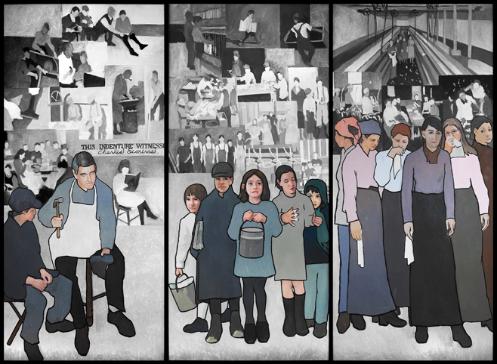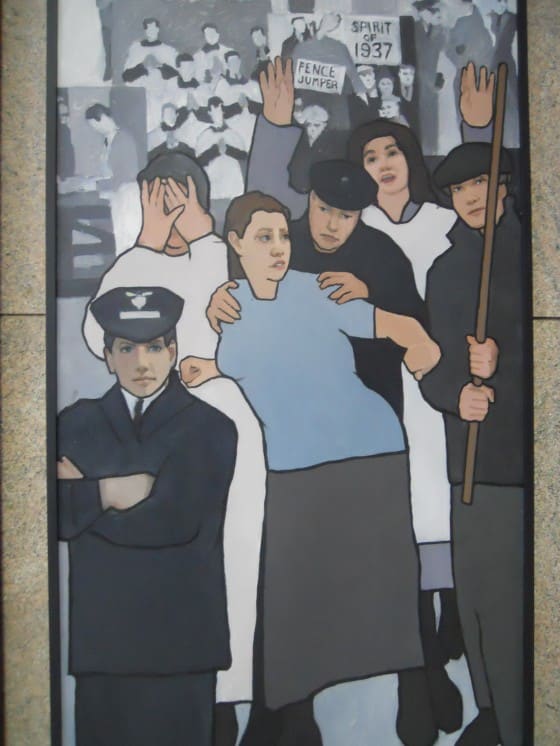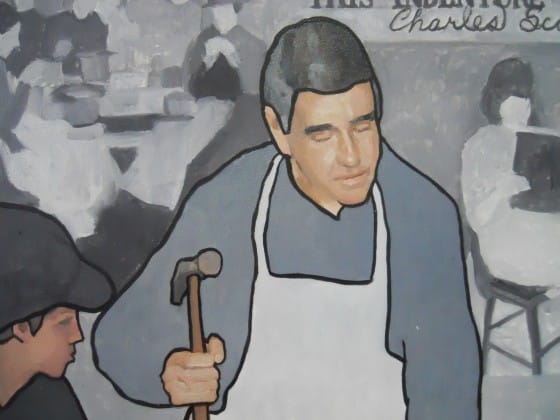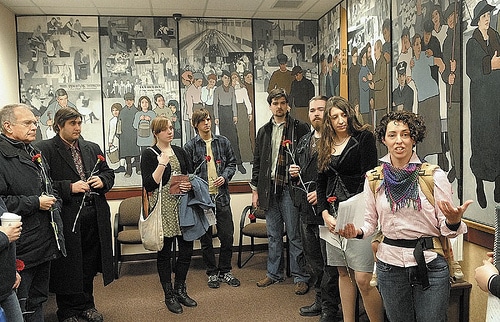Magazine
Maine Labor History Mural Restored
On Monday, January 14, the Maine State Museum and Maine Department of Labor held a surprise news conference at 8:30 a.m. to announce that the now famous Maine Labor History Mural that Gov. Paul LePage ordered removed from the labor department waiting room in March of 2011 would hang in the atrium of the state […]

 In November of 2012, however, the First Circuit Court of Appeals in Boston upheld Woodcock’s decision.
Also in November of 2012, Gov. LePage’s controversial administration was dealt a heavy blow by voters, who took away control of the state legislature from Republicans and, thus, returned appointment of constitutional officers such as Attorney-General to Democrats. Some folks in hindsight seem to think that the appointment of Democratic AG Janet Mills, who does not support LePage’s mural ban, had something to do with it coming out of the closet. I’m not so sure.
In November of 2012, however, the First Circuit Court of Appeals in Boston upheld Woodcock’s decision.
Also in November of 2012, Gov. LePage’s controversial administration was dealt a heavy blow by voters, who took away control of the state legislature from Republicans and, thus, returned appointment of constitutional officers such as Attorney-General to Democrats. Some folks in hindsight seem to think that the appointment of Democratic AG Janet Mills, who does not support LePage’s mural ban, had something to do with it coming out of the closet. I’m not so sure.
 My fellow muralistas were quick to cry “Victory” when the surprise announcement, an unusual Sunday press release, came, but again I am not too sure. Two years ago when LePage ordered the labor mural removed there were offers to hang it both at Portland City Hall and the Museum L-A in Lewiston, but mural defenders would have none of it. They demanded that the mural be returned to its original site in the DOL waiting room. If hanging the mural where the public can see it is victory, then we could have had victory two years ago by hanging it in Portland or Lewiston.
Jeff Young, the lead attorney in the mural lawsuit, had suggested in recent months, however, that the Maine State Museum might be a logical home for the labor mural. Most of us figured it would just be a matter of waiting until LePage left office before the mural would be taken out of storage and rehung somewhere.
My fellow muralistas were quick to cry “Victory” when the surprise announcement, an unusual Sunday press release, came, but again I am not too sure. Two years ago when LePage ordered the labor mural removed there were offers to hang it both at Portland City Hall and the Museum L-A in Lewiston, but mural defenders would have none of it. They demanded that the mural be returned to its original site in the DOL waiting room. If hanging the mural where the public can see it is victory, then we could have had victory two years ago by hanging it in Portland or Lewiston.
Jeff Young, the lead attorney in the mural lawsuit, had suggested in recent months, however, that the Maine State Museum might be a logical home for the labor mural. Most of us figured it would just be a matter of waiting until LePage left office before the mural would be taken out of storage and rehung somewhere.
 “While this is not the legal outcome I would like to have seen,” writes Jeff Young, “I think our efforts succeeded in making the mural such a public piece of art that as the Gov’s spokesman apparently said, it is now a part of Maine history.”
The solution to many problems in this life is simply for enough time to pass for the problem to disappear on its own. What seems to have happened in the case of the Maine Labor History Mural is that, with litigation at an end, new Maine State Museum director Bernard Fishman, former director of the Rhode Island Historical Society, approached new Maine Labor Commissioner Jeanne Pacquette about exhibiting the mural in the museum lobby. Artist Judy Taylor was consulted on the move and consented. Gov. LePage apparently had no objections. And the U.S. DOL, which paid for the mural and had been demanding its money back if the mural were not exhibited, agreed that it would be okay for the mural to hang, at least temporarily, in a non-labor department facility.
“While this is not the legal outcome I would like to have seen,” writes Jeff Young, “I think our efforts succeeded in making the mural such a public piece of art that as the Gov’s spokesman apparently said, it is now a part of Maine history.”
The solution to many problems in this life is simply for enough time to pass for the problem to disappear on its own. What seems to have happened in the case of the Maine Labor History Mural is that, with litigation at an end, new Maine State Museum director Bernard Fishman, former director of the Rhode Island Historical Society, approached new Maine Labor Commissioner Jeanne Pacquette about exhibiting the mural in the museum lobby. Artist Judy Taylor was consulted on the move and consented. Gov. LePage apparently had no objections. And the U.S. DOL, which paid for the mural and had been demanding its money back if the mural were not exhibited, agreed that it would be okay for the mural to hang, at least temporarily, in a non-labor department facility.









I think Beem’s piece is a fantastic bit of sober analysis. It is moderate and clearly dedicated to a fair representation of the situation.
I don’t agree with him about the meaning and the timing of the LePage administration’s actions. I think the sudden course of action is absolutely tied to the sweeping out of the Republican-controlled legislature and attorney general and the return of Janet Mills and a Democratic legislature. I think the incredible political reversal was at least in some small part due to LePage’s chilling censorship of the mural and arrogant response to the people who spoke out against it. Muralgate may have been the first defining act of the LePage administration and it’s clear the people of Maine disapproved – as evidenced by the 2012 election results.
I absolutely believe this is a clear victory for the Muralistas, the people of Maine and those who support the First Amendment. Political pressure may seem vague and indirect, but it’s one of the best reasons for action in our democratic republic.
If LePage had tried to continue to hide the “North Korean propaganda” and would have found himself completely alone by the end of this month. If the violation had continued, he could have found his seizing of the mural to be the reason for impeachment hearings.
I have no doubt the LePage administration felt they had to race for a solution before the new AG and incoming legislature had time to act. It’s hardly by chance that LePage took action that complied with both the demands of the Muralistas and the US DoL – especially in light of his attitude towards those who spoke out against his actions.
Beem is correct to say there is more to be done if this is to be a complete victory for those who stood up against LePage, but in terms of the governor’s relenting and not getting away with one of the most chilling acts of censorship in recent American history, then this is not only a clear victory, but a great and important one as well.
For those who don’t know Dan Kany, he is a distinguished art critic for the Maine Sunday Telegram and one of the organizers of the mural protests. Thanks, Dan.
Maine is fortunate to have these two thoughtful and articulate writers and art critics. Their analysis and reflections help us to understand the ways in which the interests of art intersect with the politics of our times here in Maine and beyond. The Labor Mural story had resonance beyond Maine’s borders, bringing to light the modus operandi of the LePage administration in it’s early days.